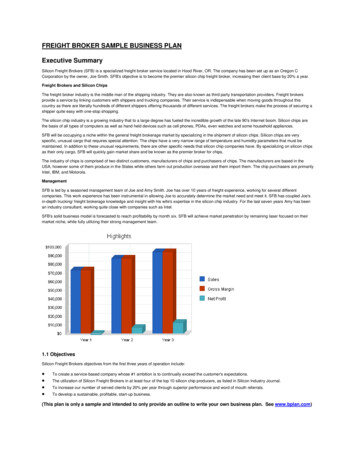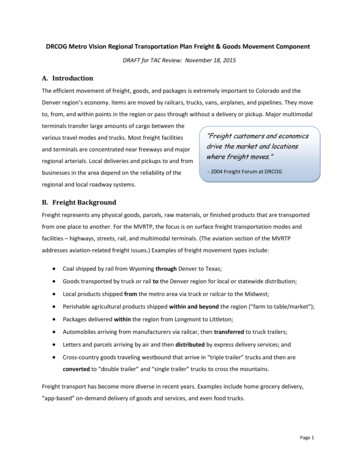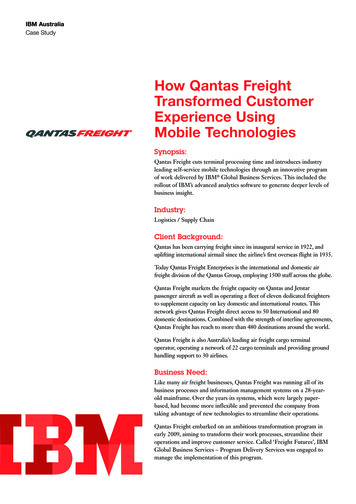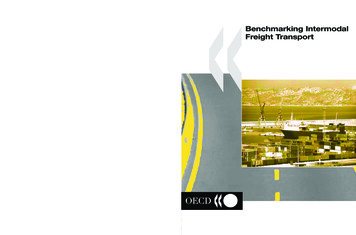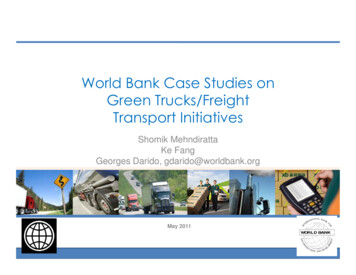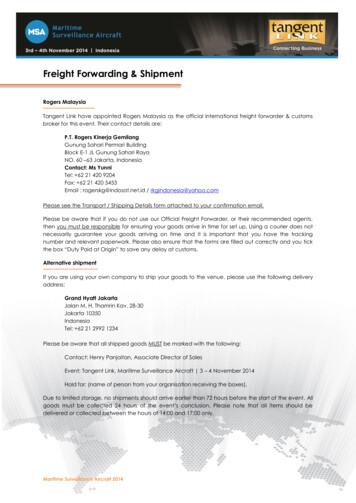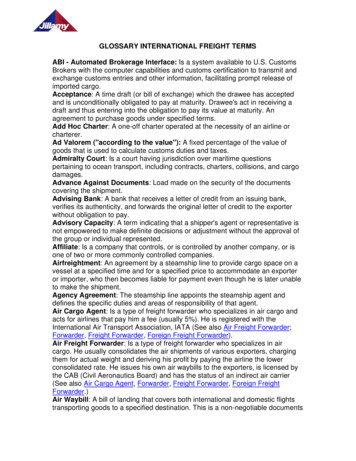
Transcription
GLOSSARY INTERNATIONAL FREIGHT TERMSABI - Automated Brokerage Interface: Is a system available to U.S. CustomsBrokers with the computer capabilities and customs certification to transmit andexchange customs entries and other information, facilitating prompt release ofimported cargo.Acceptance: A time draft (or bill of exchange) which the drawee has acceptedand is unconditionally obligated to pay at maturity. Drawee's act in receiving adraft and thus entering into the obligation to pay its value at maturity. Anagreement to purchase goods under specified terms.Add Hoc Charter: A one-off charter operated at the necessity of an airline orcharterer.Ad Valorem ("according to the value"): A fixed percentage of the value ofgoods that is used to calculate customs duties and taxes.Admiralty Court: Is a court having jurisdiction over maritime questionspertaining to ocean transport, including contracts, charters, collisions, and cargodamages.Advance Against Documents: Load made on the security of the documentscovering the shipment.Advising Bank: A bank that receives a letter of credit from an issuing bank,verifies its authenticity, and forwards the original letter of credit to the exporterwithout obligation to pay.Advisory Capacity: A term indicating that a shipper's agent or representative isnot empowered to make definite decisions or adjustment without the approval ofthe group or individual represented.Affiliate: Is a company that controls, or is controlled by another company, or isone of two or more commonly controlled companies.Airfreightment: An agreement by a steamship line to provide cargo space on avessel at a specified time and for a specified price to accommodate an exporteror importer, who then becomes liable for payment even though he is later unableto make the shipment.Agency Agreement: The steamship line appoints the steamship agent anddefines the specific duties and areas of responsibility of that agent.Air Cargo Agent: Is a type of freight forwarder who specializes in air cargo andacts for airlines that pay him a fee (usually 5%). He is registered with theInternational Air Transport Association, IATA (See also Air Freight Forwarder;Forwarder, Freight Forwarder, Foreign Freight Forwarder).Air Freight Forwarder: Is a type of freight forwarder who specializes in aircargo. He usually consolidates the air shipments of various exporters, chargingthem for actual weight and deriving his profit by paying the airline the lowerconsolidated rate. He issues his own air waybills to the exporters, is licensed bythe CAB (Civil Aeronautics Board) and has the status of an indirect air carrier(See also Air Cargo Agent, Forwarder, Freight Forwarder, Foreign FreightForwarder.)Air Waybill: A bill of landing that covers both international and domestic flightstransporting goods to a specified destination. This is a non-negotiable documents
of air transport that serves as a receipt for the shipper, indicating that the carrierhas accepted the goods listed and obligates itself to carry the consignment to theairport of destination according to specified conditions.AITA: International Air Transport Association, IATA, (French, German).All-Risk Clause: Is an insurance provision that all loss or damage to goods isinsured except that of inherent vice (self caused). (See All Risk Insurance).All Risk Insurance: Is a clause included in marine insurance policies to coverloss and damage from external causes, such as fire, collision, pilferage, etc. butnot against innate flaws in the goods, such as decay, germination, nor againstfaulty packaging, improper packing/ loading or loss of market, nor against war,strikes, riots and civil commotions (See Marine Insurance)Alongside: A phrase referring to the side of a ship. Goods to be delivered"alongside" are to be placed on the dock or barge within reach of the transportship's tackle so that they can be loaded abroad the ship.Arbitration Clause: Is a standard clause to be included in the contracts ofexporters and importers, as suggested by the American Arbitration Association. Itstates that any controversy or claim will be settled by arbitration in accordancewith the rules of the American Arbitration Association.Assignment: The transfer of the rights, duties, responsibilities and/or benefits ofan agreement, contract, or financial instrument to third party.Assignment of Proceeds: A stipulation within a letter of credit in which some orall of the proceeds are assigned from the original beneficiary to one or moreadditional beneficiaries.A.T.: American Terms (Marine Insurance) A term used to differentiate betweenthe conditions of American Policies from those of other nations, principallyEngland.Automated Brokerage Interface (ABI): An electronic system allowingcustomhouse brokers and importers to interface via computer with the USCustoms Service for transmitting entry and entry summary data on importedmerchandise.Automated Commercial System (ACS): The electronic system of the USCustoms Service, encompassing a variety of industry sectors, that permits on-lineaccess to information in selected areas.Automated Manifest System (AMS): The electronic system allowing a manifestinventory to be transmitted to the US Customs Service data center by carrier, portauthority or service center computers.BAA: British Airports AuthorityBACA: Baltic Air Charter AssociationBalance of Trade: The difference between a country's total imports and exports;if exports exceed imports, favorable balance of trade exists, if not, a trade deficitis said to exist.Barter: Trade in which merchandise is exchanged directly for other merchandisewithout use of money. Barter is an important means of trade with countries usingcurrency that is not readily convertible.B/B: Cargo transported via cargo ship in bags, boxes, crates, drums, or barrels.(Break-Bulk Cargo)Belly Cargo: Freight accommodation below the main deck.
Beneficiary: A firm or person on whom a letter of credit has been drawn. Thebeneficiary is usually the seller or exporter.Bermuda Agreement: An agreement concluded in 1946 between the U.K. andthe U.S., designed to regulate future international air traffic. Most governmentsaccept its principles and follow it inter alia by limiting traffic rights on internationalroutes to one or two carriers.Berth: Is the place beside a pier, quay or wharf where a vessel can be loaded ordischarged.Berth Liner Service: Is a regular scheduled steamship line with regularpublished schedules (port of call) from and to defined trade areas.Berth or Liner Terms: Is an expression covering assessment of ocean freightrates generally implying that loading and discharging expenses will be for shipowner's account, and usually apply from the end of ship's tackle in port of loadingto the end of ship's tackle in port of discharge.Bill of Lading: A document that establishes the terms of a contract between ashipper and a transportation company under which freight is to be movedbetween specified points for a specified charge. Usually prepared by the shipperon forms issued by the carrier, it serves as a document of title, contract ofcarriage, and a receipt for goods. (Also see Air Waybill and Ocean Bill of Lading)Bonded Warehouse: A warehouse storage area or manufacturing facility inwhich imported goods may be stored or processed without payment of customsduties.Brussels Tariff Nomenclature Number (BTN): The customs tariff number usedby most European nations. The United States does not use the BTN, but asimilar system known as the Harmonize Tariff Schedule.CAA: Is the Civil Aviation Authority. Government body responsible for regulatingU.K. airlines.Cabotage: Is where cargo is carried on what is essentially a domestic flight andtherefore not subject to international agreements that fix set rates. Cabotagerates are negotiable between shipper and airline and apply on flights within acountry and to its overseas territories.CAD Can have two meanings in the industryCAD: The acronym meaning "cash against documents," a method of payment forgoods in which documents transferring title are given to the buyer upon paymentof cash to an intermediary acting for the seller.CAD/CAM: Computer Aided Design/Computer Aided Manufacturing.Cage: The transporting of goods by truck to or from a vessel, aircraft, or bondedwarehouse, all under customs custody.Cargo: Is merchandise/commodities/freight carried by means of transportation.Cargo Receipt: Is a receipt of cargo for shipment by a consolidator (used inocean freight).Carnet: A customs document permitting the holder to carry or send merchandisetemporarily into certain foreign countries (for display, demonstration, or similarpurpose) without paying duties or posting bonds.Carriers(s) Containers or Shipper(s) Containers: The term Carrier(s)Container(s) or Shipper(s) Container(s) means containers over which the carrier
or the shipper has control either by ownership or by the acquisition thereof underlease or rental from container companies or container suppliers or from similarsources. Carriers are prohibited from purchasing, leasing or renting shipperowned containers.Carrier, Common: A public or privately owned firm or corporation that transportsthe goods of others over land, sea, or through the air, for a stated freight rate. Bygovernment regulation, a common carrier is required to carry all goods offered ifaccommodations are available and the established rate is paid.Cartel: Is an association of several independent national or international businessorganizations that regulates competition by controlling the prices, the production,or the marketing of a product or an industry.Cash in Advance (C.I.A.): Payment for goods in which the price is paid in fullbefore shipment is made. This method is usually used only for small purchases orwhen the goods are built to order.Cash Against Documents (CAD): Payment for goods in which a commissionhouse, or other intermediary, transfers title documents to the buyer upon paymentin cash.C.C.E.F.: Is a Customs Centralized Examination Facility.Certificate of Analysis: Is a certificate required by some countries as proof ofthe quality and composition of food products or pharmaceuticals. The requiredanalysis may be made by a private or government health agency. The certificatemust be legalized by a foreign consul of the country concerned, as is the casewith such similar certificates as the phytosanitary certificate.Certificate of Inspection: A document certifying that the goods were in apparentgood condition immediately prior to shipment.Certificate of Manufacture: A statement in which a producer specifies where hisgoods were manufactured, certifies that manufacturing has been completed, andconfirms that the goods are at the buyer's disposal.Certificate of Origin: A statement signed by the exporter, or his agent, andattested to by a local Chamber of Commerce, indicating that the goods beingshipped, or a major percentage of them, originated and were produced in theexporter's country.CES: Is a Customs Examination StationC&F: Is a quoted price includes cost of goods and freight.C & I: Is a quoted price includes cost of goods and insurance.CFS (Container Freight Station): The term CFS at loading port means thelocation designated by carriers for the receiving of cargo to be packed intocontainers by the carrier. At discharge ports, the term CFS means the bondedlocation designated by carriers in the port area for unpacking and delivery ofcargo.CFS/CFS (Pier to Pier): The term CFS/CFS means cargo delivered by breakbulk to Carrier's CFS to be packed by Carrier into containers and to be unpackedby Carrier from the container at Carrier's destination port CFS.CFS/CY (Pier to House): The term CFS/CY means cargo delivered break-bulk toCarrier's CFS to be packed by Carrier into containers and accepted by
consignee at Carrier's CY and unpacked by the consignee off Carrier'spremises, all at consignee's risk and expense.CFS CHARGE (Container Freight Charge): The term CFS Charge means thecharge assessed for services performed at the loading or discharging port inpacking or unpacking of cargo into/from containers at CFS.CFS Receiving Service: The term "CFS Receiving Services" means the serviceperformed at loading port in receiving and packing cargo into containers fromCFS to CY or shipside. "CFS Receiving Services" referred herein are restrictedto the following1. Moving empty containers from CY to CFS2. Drayage of loaded containers from CFS to CY and/or ship's tackle3. Tallying4. Issuing dock receipt/shipping order5. Physical movement of cargo into, out of and within CFS6. Stuffing, sealing and marking containers7. Storage8. Ordinary sorting and stacking9. Preparing carrier's internal container load planCIF (cost, insurance and freight): Seller is responsible for inland freight, ocean/air freight, and marine/air insurance to the port of final entry in the buyer'scountry. The buyer is responsible for inland transportation to his or her location.Chargeable Kilo: Rate for goods where volume exceeds six cubic metres to thetonne.Charter: Originally meant a flight where a shipper contracted hire of an aircraftfrom an airline. Has usually come to mean any non-scheduled commercialservice.Charter Party: The contract between the owner of a ship and the individual orcompany chartering it. Among other specifications, the contract usually stipulatesthe exact obligations of the ship-owner (loading the goods, carrying the goods toa certain point, returning to the charterer with other goods, etc.); or it provides foran outright leasing of the vessel to the charterer, who then is responsible for hisown loading and delivery. In either case, the charter party sets forth the exactconditions and requirements agreed upon by both sides.Charter party Bill of Lading: A bill of lading issued under a charter party. It isnot acceptable by banks under letters of credit unless so authorized in the credit.Chassis: A wheel assemble including bogies constructed to accept mounting ofcontainers.CIA: The acronym meaning "cash in advance," a method of payment for goodswhereby buyer pays seller in advance of shipment of goods.C.I.F.: Is a quoted price includes cost of goods, insurance and freight.C.I.T.E.S.: Committee on International Trade of Endangered Species.Class Rates: A class of goods or commodities is a large grouping of variousitems under one general heading. All items in the group make up a class. Thefreight rates that apply to all items in the class are called class rates.Classification: Is a customs term. The placement of an item under the correctnumber in the customs tariff for duty purposes. At times this procedure becomes
highly complicated; it is not uncommon for importers to resort to litigation overthe correct duty to be assessed by the customs on a given item.Claused Bill of Lading: Is a bill of lading which has exemptions to the receipt ofmerchandise in "apparent good order" noted.Clean Bill of Lading: Is a bill of lading which covers goods received in "apparentgood order and condition" and without qualification.Clean Draft: Is a draft to which no documents have been attached.cm: CentimetersCNS: Cargo Network Services, an IATA company. See IATA.Collective Paper: All documents (commercial invoices, bills of lading, etc.)submitted to a buyer for the purpose of receiving payment for a shipment.Commercial Risk: Risk carried by the exporter (unless insurance is secured)that the foreign buyer may not be able to pay for goods delivered on an openaccount basis.Confirmed Letter of Credit: A letter of credit, issued by a foreign bank, withvalidity confirmed by a U.S. bank. An exporter who requires a confirmed letter ofcredit from the buyer is assured of payment by the U.S. bank even if the foreignbuyer or the foreign bank defaults.Conference: A group of vessel operators joined together for the purpose ofestablishing freight rates. RoRo/Container Vessel - Ship designed to accommodate containers androll-on roll-off cargo. It can be self sustaining. RoRo/Container/Break-bulk Vessel - Designated to accommodate threetypes of cargo, usually self sustaining.Commercial Code: A published code designed to reduce the total number ofwords required in a cablegram.Commodity Specialist: An official authorized by the U.S. Treasury to determineproper tariff and value of imported goods.Consignee: Person or firm to whom goods are shipped under a bill of landing.Consular Declaration: A formal statement, made to the consul of a foreigncountry, describing goods to be shipped.Consular Invoice: A document, required by some foreign countries, describinga shipment of goods and showing information such as the consignor, consignee,and value of the shipment. Certified by consular official of the foreign, it is usedby the country's customs official to verify the value, quantity, and nature of theshipment.Combi: Is an aircraft with pallet or container capacity on its main deck as well asin its belly holds.Combination Vessels: Container/Break-bulk vessel - this type of shipaccommodates both container and break-bulk cargo. It can be either selfsustaining or non-self sustaining.Commercial Invoice: An itemized list of goods shipped, usually included amongan exporter's collection papers.Common Carrier: A firm or individual that transports persons or goods forcompensation.
Confirmed Letter of Credit: A letter of credit, issued by a foreign bank withvalidity confirmed by a U.S. bank.Confiscation: The taking and holding of private property by a government or anagency acting for a government. Compensation may or may not be given to theowner of the property.Consignee: The individual or company to whom a seller or sipper sendsmerchandise and who, upon presentation of necessary documents, isrecognized as merchandise owner for the purpose of declaring and payingcustoms duties.Consignee Marks: A symbol laced on packages for identification purposes;generally consisting of a triangle, square, circle, diamond, cross, with letters and/or numbers as well as port of discharge.Consignment: Is the physical transfer of goods from a seller (consignor) withwhom the title remains, to another legal entity (consignee) who acts as a sellingagent, selling the goods and remitting the new proceeds to the consignor.Consignor: A term used to describe any person who consigns goods to himselfor to another party in a bill of lading or equivalent document. A consignor mightbe the owner of the goods, or a freight forwarder who consigns goods on behalfof his principal.Consolidated Shipment: An arrangement whereby various shippers pool theirboxed goods on the same shipment, sharing the total weight charge for theshipment.Consolidator: An agent which brings together a number of shipments for onedestination to qualify for preferential airline rates.Consortium: The name for an agreement under which several nations ornationals (usually corporations) of more than one nation, join together for acommon purpose. It could be for management or exploitation of a naturalresource, as in the case of some international petroleum consortiums.Consul: A government official residing in a foreign country, charged withrepresenting the interests of his or her country and its nationals.Consular Documents: Special forms signed by the consul of a country to whichcargo is destined.Consular Invoice: A document, required by some foreign countries, describing ashipment of goods and showing information such as the consignor, consignee,and value of the shipment. Certified by a consular official of the foreign country, itis used by the country's customs officials to verify the value, quantity and natureof the shipment.Container: The term container means a single rigid, non-disposable dry cargo,insulated, temperature controlled flatrack, vehicle rack portable liquid tank, oropen top container without wheels or bogies attached, having not less than 350cubic feet capacity, having a closure or permanently hinged door that allowsready access to the cargo (closure or permanently hinged door not applicable toflatrack vehicle rack or portable liquid tank). All types of containers will haveconstructions, fittings and fastenings able to withstand without permanentdistortion, all the stresses that may be applied in normal service use ofcontinuous transportation. All containers must bear manufacturer's specifications.
Container Ship: Ocean going ship designed to carry containers both internallyand on deck. Some are self sustaining.Containerization: Is a concept for the ultimate unitizing of cargo used by bothsteamship lines and air cargo lines. Containers allow a greater amount of cargoprotection from weather, damage, and theft.Containers (Air Cargo): Many types of air cargo containers are offered: Thecontainers are designed in various sizes and irregular shapes to conform to theinside dimensions of a specific aircraft.Containers (Ocean): Are designed to be moved inland on its own chassis andcan be loaded at the shippers plant for shipment overseas. Basic types ofcontainers are; dry van, open top, half high, hi cube, flat rock, tank container,refrigerated container, insulated container, tilting container. Average outsidedimensions are generally 20, 35, and 40 feet in length, 8 feet wide and 8 feethigh standard.Continuous Bond: Is an annual customs bond insuring compliance with allregulations and requirements.Contract Rate: Is a charge levied by carriers selling capacity forward over agiven route to a shipper of forwarder; the client is therefore assured of capacity,which must be paid for regardless of load carried.Coordinating Committee for Export Controls (COCOM): An informal group of15 western countries established to prevent the export of certain strategicproducts to potentially hostile nations.Correspondent Bank: A bank that, in its own country, handles the business ofa foreign bank.Countertrade: Is a reciprocal trading arrangement, which includes a variety oftransactions involving two or more parties.Countervailing Duties: Is a special duties imposed on imports to offset thebenefits of subsidies to producers or exporters of the exporting country.Credit Risk Insurance: Insurance designed to cover risks of nonpayment fordelivered goods.Customs Bonded Warehouse: Is a warehouse where imported goods may bestored for a total of three years without the payment of duty or taxes.Customhouse Broker: An individual or firm licensed to enter and clear goodsthrough Customs.Customs Court: Is the court to which importers might appeal or protestdecisions made by Customs officers.Customs Tariff: Is a schedule of charges assessed by the federal governmenton imported goods.Customs Union: Is an agreement between two or more countries in which theyarrange to abolish tariffs and other import restrictions on each other's goods andestablish a common tariff for the imports of all other countries.CWO: The acronym meaning "cash with order," a method of payment for goodswhere cash is paid at the time of order and the transaction becomes binding onboth buyer and seller.CY (Container Yard): The term CY means the location designated by Carrier inthe port terminal area for receiving, assembling, holding, storing and delivering
containers, and where containers may be picked up by shippers or re-deliveredby consignees. No container yard (CY) shall be a shipper's, consignee's,NVOCC's, or a forwarder's place of business, unless otherwise provided.CY/CFS (House to Pier): The term CY/CFS means containers packed byshipper of carrier's premises and delivered by shipper to Carrier's CY, all atshipper's risk and expense and unpacked by Carrier at the destination port CFS.CY/CY (House to House): The term CY/CY means containers packed byshipper off Carrier's premises and delivered by shipper to Carrier's CY andaccepted by consignee a t Carrier's CY and unpacked by consignee off Carrier'spremises, all at the risk and expense of cargo.Dangerous Goods: Articles or substance capable of posing a significant risk tohealth, safety or property, and that ordinarily require special attention when beingtransported.DAT: Dangerous articles tariff.Date Draft: Draft that matures in a specified number of days after the date it isissued, without regard to the date of Acceptance. See Draft.DCA: Department of Civil Aviation. Commonly used term to denote thegovernment department of any foreign country that is responsible for aviationregulation and granting traffic rights.DDP: Delivered duty paid. Also known as "free domicile."DDU: Delivered duty unpaid. Reflects the emergence of "door-to-door"intermodal or courier contracts or carriage where only the destination customsduty and taxes (if any) are paid by consignee.Dead Leg: Is a sector flown without payload.Dead Freight: Is freight charges paid by the charterer of vessel for thecontracted space, which is left partially unoccupied.Deck Cargo: Is cargo carried on deck rather than stowed under deck. On deckcarriage is required for certain commodities, such as explosives.Deferred Payment Credit: Type of letter of credit providing for payment sometime after presentation of shipping documents by exporter.Deferred Rebate: The return of a portion of the freight charges by a carrier or aconference shipper in exchange for the shipper giving all or most of hisshipments to the carrier or conference over a specified period of time (usually 6months). Payment of the rate is deferred for a further similar period, during whichthe shipper must continue to give all or most of his shipments to the rebatingcarrier or conference. The shipper thus earns a further rebate which will not,however, be paid without an additional period of exclusive or almost exclusivepatronage with the carrier of conference. In this way, the shipper becomes tied tothe rebating carrier or conference. Although, the deferred rebate system is illegalin U.S. foreign commerce, it generally is accepted in the ocean trade betweenforeign countries.Demurrage: A penalty for exceeding free time allowed for loading or unloadingat a pier or freight terminal. Also a charge for undue detention of transportationequipment or carriers in port while loading or unloading.Density: Density means pounds per cubic foot. The cubage of loose articles orpieces, or packaged articles of a rectangular, elliptical or square shape on one
plane shall be determined by multiplying the greatest straight line dimensions oflength, width and depth in inches, including all projections, and dividing the totalby 1728 (to obtain cubic feet). The density is the weight of the article divided bythe cubic feet thus obtained.DEQ: Delivered ex quay/duty paid.Destination Control Statement: Any of various statements that the U.S.government requires to be displayed on export shipments and that specify thedestination for which export of the shipment has been authorized.D.F.: Dead FreightDGR: Dangerous Goods Requirement.Dim Weight: (Dimensionalized Weight) Determined by calculating length x widthx height and dividing by 166. Charged when actual weight is less than the dim.weight.Dock Receipt: When cargo is delivered to a steamship company at the pier, thereceiving clerk issues a dock receipt.Documents Against Acceptance (D/A): Instructions given by a shipper to abank indicating that documents transferring title goods should be delivered to thebuyer (or drawee) only upon the buyer's acceptance of the attached draft. DOT:Department of TransportationDraft (or Bill of Exchange): An unconditional order in writing from one person(the drawer) to another (the drawee), directing the Drawee to pay a specifiedamount to a named Drawer at a fixed or determinable future date.Drawback: A U.S. customs law that permits an American exporter to recoverduties paid on imported foreign raw materials or components included in productsthat are subsequently exported out of the United States.Drawee: The individual or firm on whom a draft is drawn and who owes thestated amount to the drawer.Dry Lease: The rental of a "clean" aircraft without crew, ground staff orsupporting equipment.DST: The acronym meaning "double stack train" service, which is the transportrail between two points of a trainload of containers with two containers, one ontop of the other, per chassis.d.w.: Deadweight (tons of 2,240 lbs.)d.w.c.: Deadweight for cargoE.A.O.N.: Except as otherwise noted.EDI or EDIFACT: Electronic Data Interchange for Administration, Commerce andTransport, from the UN-backed electronic data interchange standards body, tocreate electronic versions of common business documents that will work on aglobal scale. One digital document under consideration, the InternationalForwarding and Transport Message will do the jobs of six different electronicmessages currently in use.Empty Leg: Results from an aircraft primarily chartered outbound having cargocapacity inbound or vice versa. A cheap form of airfreight.Endorsement in Blank: Commonly used on a bank check, an endorsement inblank is an endorsement to the bearer. It contains only the name of the endorserand specifies no particular payee. Also, a common means of endorsing bills of
lading dawn to the order of the shipper. The bills are endorsed "For."(See Bill of Lading)Eurodollars: U.S. dollars on deposit outside of the United States to includedollars on deposit at foreign branches of U.S. banks, and dollars on deposit withforeign banks."Ex": Signifies that the quoted price applies only at the indicated point of origin(e.g. "price ex factory" means that the quoted price is for the goods available atthe factory gate of the seller).Ex. B.L.: Exchange bill of lading.Export Broker: The individual who brings together buyer and seller for a fee,eventually withdrawing from any transaction.Export Declaration: A form to be completed by the exporter or their authorizedagent and filed in triplicate by a carrier with the United State Collector of customsat the point of exit. It serves a twofold purpose:1. Primarily, it is used by the U.S. Bure
Air Cargo Agent: Is a type of freight forwarder who specializes in air cargo and acts for airlines that pay him a fee (usually 5%). He is registered with the International Air Transport Association, IATA (See also Air Freight Forwarder; Forwarder, Freight Forwarder, Foreign Freight Forwarder).
